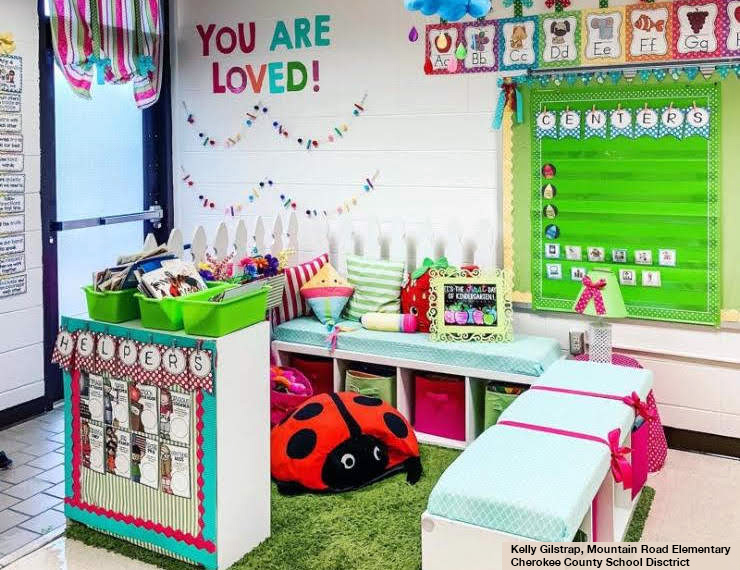
 Kelly Gilstrap‘s Kindergarten Classroom at Mountain Road Elementary School in the Cherokee County School District
Kelly Gilstrap‘s Kindergarten Classroom at Mountain Road Elementary School in the Cherokee County School DistrictOver the years as an educator and a professional educational consultant, I have often reflected on the importance of the ecological context of a learning environment. How does the environment of the classroom “get children in the mood” for learning?
A few years ago I had a family reunion in Atlanta. My immediate family, including my six-year-old nephew, checked into the hotel before I did. When they arrived at the hotel and went to the room to unpack, my nephew exclaimed, “Is this it?!,” as if his entire vacation had been ruined. My mom chuckled; she was very surprised to hear him make such a statement at his age.
Later, when I arrived, I understood his reaction, immediately packed our belongings and checked us into a new hotel. As we entered the new hotel and went up to our room I watched for my nephew’s reaction. This time when he entered the room, he said, “Now this is more like it!” smiling as if this would be the best trip ever.
What impression do you aim to make on your students when they enter your classroom? The average student spends up to 1,260 hours in the classroom annually. It’s important to create a space they can be proud of and excited to spend time over those 180 days. Consider these tips to (re)design your classroom space to keep students engaged and excited in their learning environment.
Create a comfortable and inviting space
Students unconsciously make assumptions about the expectations of the teacher and the type of year they will have based on the classroom environment. Bare walls and an unorganized room with little personality can communicate to the students that the teacher may have a laissez-faire attitude and is not invested in them. Students may feel less valued and lower their own expectations for success. On the contrary, a bright, thoughtful classroom space can ensure students immediately feel welcomed, comfortable, and excited about learning.
- Use color strategically. Research shows that color in classrooms can lead to higher productivity and student success. A fresh coat of paint can breathe new life into a room.
- Embrace a flexible seating arrangement. Varied seating options let students decide where they can work most comfortably and enjoyably. It also gives students a sense of autonomy to choose conditions that help them learn best.
- Display inspirational quotes. Strategically placed quotes in a classroom are a great way to set a welcoming tone and reinforce positive messages. Imagine students entering your classroom with a quote saying, “You are a genius, now show me what you are made of.”
Create a student-centered space
As educators, we often prioritize our own needs and how we want to use the space when designing a classroom. We consider where we will sit and work, how we will organize our materials, even where we will keep our personal belongings and snacks. While self-care is really important, the students’ comfort level is critical to optimize their success and can make a world of difference in your own professional satisfaction.
- Incorporate a theme. This is a creative and fun way to unify the various spaces in the room. Your theme may be “Out of this World” and you could decorate your classroom with different types of space paraphernalia.
- Create designated areas. Ensure that all spaces are used purposefully so that students have the ability to work collaboratively, be creative, and display their art and work products.
- Make materials accessible. Students should be able to easily access the materials they need to foster independence and ownership of completing assignments.
Put a maintenance plan in place
Maintaining a fun, comfortable and engaging classroom throughout the school year can be challenging with so many competing priorities. But remember, students of all ages can be encouraged to take on leadership responsibilities in maintaining a great classroom environment which frees up your time to focus on more pressing items. In addition, incorporating technology and some organizational routines can make a big difference.
- Delegate tasks to students. Promote student ownership of the classroom for sustainability. Assign jobs to students at the end of each period, day, or during transitions, to maintain the organization and tidiness of the classroom. It is a great motivator for students to feel responsible for a task.
- Purge before breaks. Refresh your classroom before major breaks (fall, winter, spring, and summer) by storing any resources or equipment that is no longer being used, updating anchor charts and student work displays, and discarding anything that doesn’t have a place.
- Use the cloud. Store important documents and handouts on the internet (Dropbox, iCloud, Google Drive, etc.) to prevent unwanted piles of paperwork finding its home on your tables, floors, and in your cabinets.
Your classroom design speaks volumes about the learning experience in your space even before you teach your very first lesson. With careful planning and a bit of creativity, you can create a space that students will be excited to learn in. If you are unsure about what your design is communicating or just seeking creative ideas, reach out to your students and get their opinions. Like my nephew, they are great at speaking their minds!
Leave a comment about how the design of your space has impacted teaching and learning in your classroom. What questions do you have about re(designing) your space?
